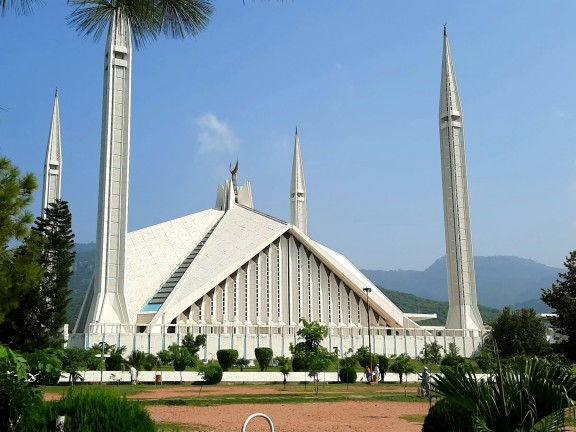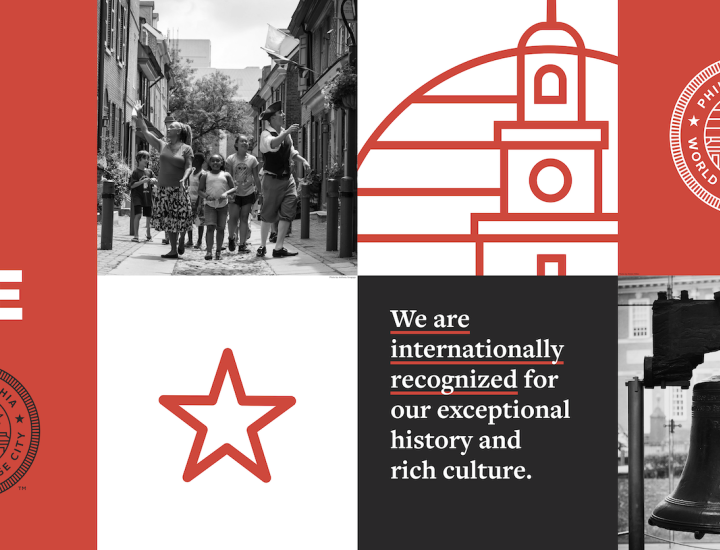Exploring Faisal Masjid: A Journey to Islamabad's Iconic Landmark

Standing nearly 300 ft tall with the Margalla Hills in the backdrop, the Faisal Masjid is instantly recognizable-— not just for its size, but for its bold, unique design and cultural symbolism. As Pakistan’s national mosque, it stands at the intersection of religion, architecture, and diplomacy. Deeply ingrained in Pakistani and Islamic culture, the Faisal Masjid, one of the world's renowned National Historic Landmarks, is located in Islamabad, Pakistan. As the national mosque of Pakistan, it is not only a place of worship but also a symbol of unity and pride for the nation. For emerging storytellers in Philadelphia — a World Heritage City full of history and heritage— visiting landmarks like this offers an opportunity to connect our own heritage with the histories of communities around the world.
There are thirteen National Historical Landmarks in Pakistan, including historic architectural sites such as The Lahore Fort and Minar-e-Pakistan, which are major tourist attractions in the country. The Badshahi Mosque, another beloved religious site steeped in cultural importance, is Pakistan's only World Heritage Site following its addition to the United Nations' coveted list in 1993. In Pakistan, a historical landmark is designated through a process of identification, expert evaluation, proposal submission, review and approval by authorities, followed by preservation efforts and public awareness initiative. National Monuments are protected under the Antiquities Act of 1975 and are overseen by the Department of Archaeology and Museums (DOAM). Faisal Masjid is designated a National Monument of Pakistan, marking its place as a major religious and cultural landmark — one that welcomes people from around the world to explore Pakistan’s Islamic traditions and its place in global cultural dialogue.
The Faisal Masjid received its name from the late King Faisal bin Abdul Aziz of Saudi Arabia and was conceived during his visit to Pakistan in 1966. The late King intended the masjid to be a symbol of the strong connection between both Saudi Arabia and Pakistan. Designed by renowned Turkish architect Vedat Dalokay, among other Pakistani engineers, the mosque broke ground in 1976 and reached its completion a decade later, in 1986. Since then, the mosque has become a major cultural and religious landmark, open to both Muslims and non-Muslims.
Visitors from around the world come to experience a place that reflects Pakistan’s identity, rooted in Islamic tradition but shaped by international collaboration. Like Philadelphia, Islamabad demonstrates how local heritage can hold global significance.
The Masjid’s unique design and nontraditional architecture allows it to stand out, making it the sixth largest mosque in the world. Inspired by a Bedouin tent, a contemporary Arabic design, the mosque features eight-sided sloping roofs forming a triangular worship hall. The Bedouin tent pays homage to Islamic history, as Dalokay claimed to attempt to capture the spirit of the Holy Kaaba in Mecca. The structure is surrounded by four towering minarets, each standing 90 meters tall. With space for 10,000 worshippers inside and another 300,000 on the surrounding grounds, it remains one of the largest mosques in the world — and one of the most visited. The masjid’s structure has remained largely unchanged, aside from necessary upkeep to support the building’s grandeur. Just as Philadelphia’s landmarks reflect multiple heritages, Faisal Masjid’s architecture and design similarly carries not only Pakistani, but Islamic and Arab roots, unifying the three to create a well-known representation of Pakistan. This blending of traditions creates a space that is both historically and globally significant, drawing visitors from around the world to experience its unique beauty and culture.
Inside, the experience is peaceful and humbling with marble floors, a striking light fixture that reminds worshippers of the sun, and verses from the Quran etched into the walls. As you enter the Faisal Masjid, visitors are required to take off their shoes and are expected to dress modestly, as a sign of respect.
The mosque is known to bring serene tranquility and peace to its visitors as the Adhan is called. The Adhan, the Islamic call to prayer, is called five times a day in the mosque, and visitors travel hundreds of miles to be able to hear the muezzin perform the call to worship. Some seek to strengthen their relationship with Islam, and others visit to simply appreciate the beauty the masjid offers.

Open to Muslims and non-Muslims alike, the Faisal Masjid invites people from around the world to engage with Pakistan’s spiritual and architectural identity. As a national mosque and a designated historical landmark, it remains one of Pakistan’s most iconic symbols. Just as Philadelphians celebrate Independence Hall as a site of global democratic legacy, the Faisal Masjid reminds us that sacred spaces, no matter where they are, help define who we are and what we choose to honor. These are the places that connect us — and inspire us to keep exploring.

